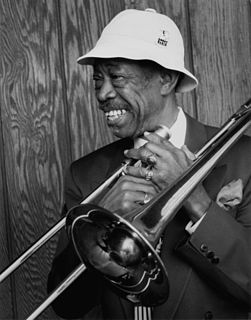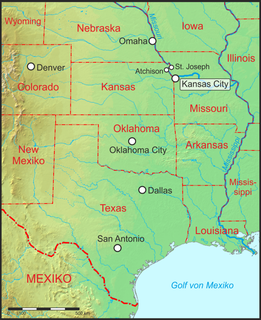
William James "Count" Basie was an American jazz pianist, organist, bandleader, and composer. In 1935, he formed the Count Basie Orchestra, and in 1936 took them to Chicago for a long engagement and their first recording. He led the group for almost 50 years, creating innovations like the use of two "split" tenor saxophones, emphasizing the rhythm section, riffing with a big band, using arrangers to broaden their sound, and others. Many musicians came to prominence under his direction, including the tenor saxophonists Lester Young and Herschel Evans, the guitarist Freddie Green, trumpeters Buck Clayton and Harry "Sweets" Edison, plunger trombonist Al Grey, and singers Jimmy Rushing, Helen Humes, Thelma Carpenter, and Joe Williams.

Joseph Vernon "Big Joe" Turner Jr. was an American blues shouter from Kansas City, Missouri. According to songwriter Doc Pomus, "Rock and roll would have never happened without him." His greatest fame was due to his rock-and-roll recordings in the 1950s, particularly "Shake, Rattle and Roll", but his career as a performer endured from the 1920s into the 1980s.
Swing music is a form of jazz that developed in the United States in the 1930s and 1940s. The name came from the emphasis on the off–beat, or weaker pulse. Swing bands usually featured soloists who would improvise on the melody over the arrangement. The danceable swing style of big bands and bandleaders such as Benny Goodman was the dominant form of American popular music from 1935 to 1946, known as the swing era. The verb "to swing" is also used as a term of praise for playing that has a strong groove or drive. Notable musicians of the swing era include Duke Ellington, Benny Goodman, Count Basie, Cab Calloway, Jimmy Dorsey, Tommy Dorsey, Woody Herman, Harry James, Lionel Hampton, Glenn Miller and Artie Shaw.

James Andrew Rushing was an American singer and pianist from Oklahoma City, Oklahoma,U.S., best known as the featured vocalist of Count Basie's Orchestra from 1935 to 1948.

The U.S. state of Missouri has a storied musical history. It has been the scene of major developments in several popular music genres as well as the birthplace of many notable musicians. St. Louis was an important venue for early blues and jazz, as well as country and bluegrass. Kansas City is home to famous performers such as Charlie Parker, Count Basie, Lester Young, and its own distinct jazz style. Ragtime got its influential hold in the city of Sedalia, Missouri, thanks to Scott Joplin and his publisher John Stark, and through another Missouri native, James Scott.

Oran Thaddeus "Hot Lips" Page was an American jazz trumpeter, singer, and bandleader. He was known as a scorching soloist and powerful vocalist.

Lester Willis Young, nicknamed "Pres" or "Prez", was an American jazz tenor saxophonist and occasional clarinetist.

Al Grey was an American jazz trombonist who was a member of the Count Basie orchestra. He was known for his plunger mute technique and wrote an instructional book in 1987 called Plunger Techniques.
James Robert Forrest Jr. was an American jazz musician, who played tenor saxophone throughout his career.

Benjamin "Bennie" Moten was an American jazz pianist and band leader born and raised in Kansas City, Missouri.

The Count Basie Orchestra is a 16 to 18 piece big band, one of the most prominent jazz performing groups of the swing era, founded by Count Basie in 1935 and recording regularly from 1936. Despite a brief disbandment at the beginning of the 1950s, the band survived long past the Big Band era itself and the death of Basie in 1984. It continues under the direction of trumpeter Scotty Barnhart.

Jonathan David Samuel Jones was an American jazz drummer. A band leader and pioneer in jazz percussion, Jones anchored the Count Basie Orchestra rhythm section from 1934 to 1948. He was sometimes known as Papa Jo Jones to distinguish him from younger drummer Philly Joe Jones.
Walter Sylvester Page was an American jazz multi-instrumentalist and bandleader, best known for his groundbreaking work as a double bass player with Walter Page's Blue Devils and the Count Basie Orchestra.
The Oklahoma City Blue Devils was the premier American Southwest territory jazz band in the 1920s. Originally called Billy King's Road Show, it disbanded in Oklahoma City in 1925 where Walter Page renamed it. The name Blue Devils came from the name of a gang of fence cutters operating during the early days of the American West.

Frank Benjamin Foster III was an American tenor and soprano saxophonist, flautist, arranger, and composer. Foster collaborated frequently with Count Basie and worked as a bandleader from the early 1950s. In 1998, Howard University awarded Frank Foster with the Benny Golson Jazz Master Award.
From Spirituals to Swing was the title of two concerts presented by John Hammond in Carnegie Hall on 23 December 1938 and 24 December 1939. The concerts included performances by Count Basie, Benny Goodman, Big Joe Turner and Pete Johnson, Helen Humes, Meade Lux Lewis, Albert Ammons, Mitchell's Christian Singers, the Golden Gate Quartet, James P. Johnson, Big Bill Broonzy and Sonny Terry.

Kansas City jazz is a style of jazz that developed in Kansas City, Missouri during the 1920s and 1930s, which marked the transition from the structured big band style to the musical improvisation style of Bebop. The hard-swinging, bluesy transition style is bracketed by Count Basie who in 1929 signed with the Bennie Moten's Kansas City Orchestra and Kansas City native Charlie Parker who ushered in the Bebop style in America. "While New Orleans was the birthplace of jazz, America's music grew up in Kansas City". Kansas City is known as one of the most popular "cradles of jazz". Other cities include New Orleans, Chicago, St. Louis, Pittsburgh, Philadelphia, and New York City. Kansas City was known for the organized musicians of the Local 627 A.F.M., which controlled a number of venues in the city.
Henry Franklin "Buster" Smith, also known as Professor Smith, was an American jazz alto saxophonist and mentor to Charlie Parker. Smith was instrumental in instituting the Texas Sax Sound with Count Basie and Lester Young in the 1930s.

Herschel "Tex" Evans was an American tenor saxophonist who was a member of the Count Basie Orchestra. He also worked with Lionel Hampton and Buck Clayton. He is also known for starting his cousin Joe McQueen's interest in the saxophone. Joe McQueen, living until 2019 at age 100, may well have been the last surviving person to have known Herschel during his lifetime.
Gene Ramey was an American jazz double bassist.












